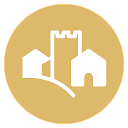SHARRYLAND


Guardia Perticara, the village of stone houses
An ancient history carved in stones

Where is

What it is and where it is
A few kilometers from Potenza and Matera is Guardia Perticara. It is a small village of a few hundred inhabitants that dominates the landscape of the Sauro River valley. Its narrow streets create a labyrinthine space that occasionally opens onto small squares or overlooks the valley, and it is then that the view widens to the surrounding panorama, blissing in the beauty of the Lucanian hinterland. That of Guardia Perticara is an unmistakably medieval structure, its history is much longer and more articulated, and it is the village itself that tells us about it.
Why it is special
Guardia Perticara is also known as the village of stone houses because its buildings have remained faithful to traditional building techniques, and they feature their characteristic "facing" stones. The village seems to be made entirely of the local stone, and through this material it tells its traditions and history. Indeed, it often happens to come across arches, stairways and lintels decorated in bas-relief whose style keeps alive the echoes of the different civilizations that have succeeded one another over time in this territory.
Not to be missed
In a place where art is an integral part of daily life, it is not surprising that there are moments dedicated to its celebration. In the month of August, for example, a series of events are followed in the village, but in particular I would recommend not to miss "the evening of the salons," as in all corners of the village there are artists exhibiting their works, and between crafts, art, music and typical gastronomy, you will be involved in the evocative warmth of Southern Italy.
A bit of history
The history of the village begins in the early Iron Age, between the 9th and 8th centuries BC. Dating back to the fifth century are the grave goods found in the San Vito area, related to the civilization of the Enotrians. Other discoveries, such as the Basilian caves, recall a Greek Orthodox presence around the 10th century. With the Saracens began a series of conquests, destructions and reconstructions that would last for centuries, flanked by plagues and earthquakes. The latest is the Irpinia earthquake of 1980, after which the village plans to recover its ancient architectural and artistic dimensions, restoring the historic center to its ancient medieval form.
Curiosities
The church of Santa Maria del Sauro houses a wooden Madonna very dear to the local faith. Legend has it that in medieval times, on the site where the shrine stands today, some peasants allegedly saw the Virgin on top of a cart pulled by oxen with stone wheels (which would have been preserved until some time ago in front of the chapel). According to one version of the legend, following the apparition, the lord who ruled in Guardia Castle at that time built the shrine at his own expense and had a statue carved corresponding to the image of the Virgin in the apparition.
Enter the Map of Italy's Undiscovered Wonders and find treasures where you least expect it... Inspire, Recommend, Share...
Contact
Collections
The Map thanks:
Enter the Map of Italy's Undiscovered Wonders and find treasures where you least expect it... Inspire, Recommend, Share...
Where is

Contact
Collections

